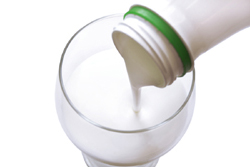- Introduction to allergies
- Breast milk
- Cow’s milk
- Nuts
- Fish
- Fats
- Vitamins and antioxidants
- Prevention
Introduction to allergies

Breast milk
It has been found that many food allergies can be caused simply by a person’s diet during childhood. This includes whether a baby has been breastfed from birth. Many studies are now showing links between breastfeeding and allergic risk but with varying explanations. It is largely believed that breastfeeding has a ‘protective’ effect.
Besides giving nutritional benefits, breast milk delivers a number of anti-inflammatory compounds and various stimulants. The anti-inflammatory compounds play the role of passively protecting the baby from certain diseases whilst their immune systems are still not fully developed. Meanwhile, stimulants such as hormones, growth factors, antioxidants and fatty acids encourage the baby’s immune system to develop.
The duration of breastfeeding is also important. A study in Canada showed links in relation to breastfeeding lengths. They found that the longer the feeding period, the lower the allergic risk. In support of this it is also generally recommended that the introduction of solid foods is delayed for quite some time as it can help prevent development of allergy.
With all these protective benefits of breastfeeding, consideration must still be given to the mother’s diet. As will be discussed later in this article, the amount and type of fat in a person’s diet can influence their allergic risk. Mothers with a high fat diet commonly found in Western societies have been shown to pass on the negative effects of their diet to their child through breast milk. As such, a healthy low fat diet is highly recommending during the breastfeeding period.
For more information, see Breastfeeding.
Cow’s milk

Hypoallergenic formula has been developed as a cow’s milk substitute and is designed to reduce chances of an allergic reaction. This is currently widely used for children at high risk of cow’s milk allergy. Soy allergy is uncommon and as such, soy formula can also be used as an alternative for children at risk of cow’s milk allergy. A number of researchers have suggested that it is the fat content in the milk that actually gives rise to allergic disease.
Nuts
Traditionally, nuts have been thought of as one of the leading causes of severe allergic reactions in adults. However, most facts discovered about nut allergies were based on studies that included both children and adults. A recent survey in France discovered that peanut and tree nut were found to account for only 4% of reported food reactions.
Research has shown that the development of nut allergy is most common in children. Although there is currently not a lot of evidence, studies are suggesting that eliminating nuts from the diet can reduce the risk of developing an allergy towards them. This includes pregnant and breastfeeding mothers as well as during the first few years of infancy.
For those at high risk of nut allergy, testing is highly recommended. Skin testing has been found to be the most sensitive option. Once a person has been established with allergies to nuts, the leading suggestion to patients is to avoid the entire food group.
Fish
In the past, fish consumption during childhood has been quite controversial and as such, many health professionals were recommending that fish be avoided during infancy. Current studies, are now finding this to be untrue. One recent study in Sweden supports the benefits of fish consumption. After following 4089 new-born infants over a period of 4 years, they found that regular consumption of fish prior to age 1 lowered the risk of certain food allergies. This included asthma, eczema, allergic rhinitis and food sensitisation. In addition to this, a number of studies are now suggesting that fish oil be supplemented during pregnancy.
Fats
There are two main types of fat that people consume:
- Saturated fats: These fats come from animal food products like cheese, meat and eggs. They are considered bad for you as they contain a lot of cholesterol
- Unsaturated fats: These fats are derived from plants such as olive oil or sunflower oil. These fats are not considered harmful in moderation and are considered a better alternative to saturated fats
Heart disease and obesity are major problems in Western societies. As such, Western diets have been progressively reducing saturated fats and increasing unsaturated fats. It has been known for years that allergic individuals have abnormal proportions of unsaturated fatty acids in their blood. As the use of unsaturated fats increased, so has the prevalence of allergic disease.
A recent study compared the difference in consumption of butter and margarine between allergic and non-allergic individuals. Butter contains more saturated fats compared to margarine which contains more unsaturated fats. It was discovered allergic children consumed more margarine and less butter than non-allergic children. This supports the idea that an imbalance of saturated and unsaturated fats is related to an increased risk of allergies.
A recent study into overweight children and their relative risk for asthma and allergy found some links between a higher Body Mass Index and increased risk. Comparative studies of Mediterranean countries of Spain, France, Italy and Greece were compared with the UK, Ireland and Australia and found that there was a lower incidence of asthma within the ‘Mediterranean diet’ countries. These diets were found to have a lower overall fat content.
Vitamins and antioxidants

It has also been found that antioxidants in the diet may have an anti-allergic effect. This theory is supported by a discovery that blood concentrations of glutathione peroxidase, an important antioxidant, are abnormally low in both adults and children with asthma. In addition, low consumption of vitamin C and manganese has been linked to risk of developing allergies.
It has been seen that consumption of dietary anti-oxidants in developed countries has been continuously declining over the last 30 years and may be contributing to the increased prevalence of allergies. It is therefore important to maintain a healthy diet that rich in fresh fruit and vegetables.
Prevention
Whilst it is still unclear what is causing the increase in allergic disease, there are a number of things that can be done to reduce risk:
- Eat a healthy low fat diet containing a balance of both saturated and unsaturated fats is beneficial.
- Eat a diet rich in fruit and vegetables
- Eat fish regularly
- Breast feed infants for at least 6 months
- If a woman is at high risk of allergy test for them prior to pregnancy to help to decide on whether certain foods should be excluded.
More information
 |
For more information on nutrition, including information on types and composition of food, nutrition and people, conditions related to nutrition, and diets and recipes, as well as some useful videos and tools, see Nutrition. |
References
- Hoppu, U., Kalliomaki, M., Laiho, K. and Isolauri, E. 2001. Breast Milk – immunomodulatory signals against allergic diseases. Allergy. 56:23-25.
- Bloomfield, S.F., Stanwell-Smith, R., Crevel, R.W.R. and Pickup, J. 2006. Too clean, or not too clean: the Hygiene Hypothesis and home hygiene. Clinical and Experimental Allergy. 36:402-425.
- Wood, R.A. 2006. Prospects for the Prevention of Allergy: A Losing Battle or a Battle Still Worth Fighting? Archives of Pediatrics and Adolescent Medicine. 160:551-554.
- Hoppu, U., Kalliomaki, M., and Isolauri, E. Arshad. 2002. Cow’s milk allergy – a matter of fat. Allergy. 57:61-62.
- Strannegard, O. And Strannegard, I.-L. 2001. The causes of the increasing prevalence of allergy: is atopy a microbial deprivation disorder? Allergy. 56:91-102.
- Hasan Arshad, S. 2001. Food allergen avoidance in primary prevention of food allergy. Allergy. 56:113-116.
- Crespo, J.F. and Rodriguez, J. 2003. Food allergy in adulthood. Allergy. 58:98-113.
- Kull, I., Bergstrom, A., Lilja, G., Pershagen, G. and Wickman, M. 2006. Fish consumption during the first year of life and development of allergic disease during childhood. Allergy. 61:1009-1015.
- Dunstan, J.A., Mori, T.A., Barden, A., Beilin, L.J., Taylor, A.L., Holt, P.G. et al. 2003. Fish oil supplementation in pregnancy modifies neonatal allergen-specific immune responses and clinical outcomes in infants at high risk of atopy: a randomized controlled trial. Journal of Allergy and Clinical Immunology. 112:1178-1184.
- Barden, A.E., Mori, T.A., Dunstan, J. A., Taylor, A.L., Thornton, C.A., Croft, K.D. et al. 2004. Fish oil supplementation in pregnancy lowers F@-isoprostanes in neonates at high risk of atopy. Free Radical Research. 38:233-239.
- Denburg, J.A., Hatfield, H.M., Cyr, M.M., Hayes, L., Holt, P.G., Sehmi, R. et al. 2005. Fish oil supplementation in pregnancy modifies neonatal progenitors at birth in infants at risk of atopy. Pediatric Research. 57:276-281.
- Dunder, T., Kuikka, L., Turtinen, J., Räsänen, L. and Uhari, M. 2001. Diet, serum fatty acids, and atopic diseases in childhood. Allergy. 56:425-428.
- Black P.N. and Sharp S. 1997. Dietary fat and asthma: is there a connection? European Respiratory Journal. 10:6-12.
- Schachter, L.M., Peat, J.K. and Salome, C.M. 2006. Asthma and atopy in overweight children. Thorax. 58:1031-1035.
- Noverr, M.C. and Huffnagle G.B. 2005. The ‘microflora hypothesis’ of allergic diseases. Clinical and Experimental Allergy. 35:1511-1520.
All content and media on the HealthEngine Blog is created and published online for informational purposes only. It is not intended to be a substitute for professional medical advice and should not be relied on as health or personal advice. Always seek the guidance of your doctor or other qualified health professional with any questions you may have regarding your health or a medical condition. Never disregard the advice of a medical professional, or delay in seeking it because of something you have read on this Website. If you think you may have a medical emergency, call your doctor, go to the nearest hospital emergency department, or call the emergency services immediately.







